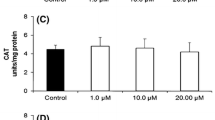Abstract
Although malondialdehyde (MDA) is extensively metabolized to CO2, small amounts are nevertheless excreted in an acid-hydrolyzable form in rat urine. In this study, urinary MDA was evaluated as an indicator of lipid peroxidation in the diet and in the tissues. MDA was released from its bound form(s) in urine by acid treatment and determined as the TBA-MA derivative by HPLC. MDA excretion by the rat was found to be responsive to oral administration of the Na enol salt and to peroxidation of dietary lipids. Urinary MDA also increased in response to the increased lipid peroxidation in vivo produced by vitamin E deficiency and by administration of iron nitrilotriacetate. Chronic feeding of a diet containing cod liver oil led to increases in MDA excretion which were not completely eliminated by fasting or feeding a peroxide-free diet, indicating that there was increased lipid peroxidation in vivo. MDA excretion was not responsive to Se deficiency or CCl4 administration. DPPD, a biologically active antioxidant, but not BHA, a non-biologically active antioxidant, prevented the increase in MDA excretion in vitamin E deficient animals. The results indicate that MDA excretion can serve as an indicator of the extent of lipid peroxidation in the diet and, under conditions which preclude a dietary effect, as an index of lipid peroxidation in vivo.
Similar content being viewed by others
References
Tappel, A.L. (1980) in Free Radicals in Biology (Pryor, W.A., ed.) Vol. IV, pp. 1–47, Academic Press, New York.
Siu, G.M., and Draper, H.H. (1982) Lipids 17, 349–355.
Siu, G.M., and Draper, H.H. (1983) J. Toxicol. Envir. Health 11, 105–119.
Bird, R.P., Hung, S.S.O., Hadley, M., and Draper, H.H. (1983) Anal. Biochem. 128, 240–244.
Siu, G.M., Hadley, M., and Draper, H.H. (1981) J. Nutrition 111, 1681–1685.
Draper, H.H., and Csallany, A.S. (1969) J. Nutrition 98, 390–394.
Schwartz, K. (1954) Ann. New York Acad. Sci. 57, 878–888.
Hoffman, T., Westerby, R.J., and Hidiroglou, M. (1968) J. Am. Oil Chem. Soc. 51, 1039–1042.
Machlin, L.J. (1978) in Tocopherol, Oxygen and Biomembranes (de Duve, C., and Hayaishi, O., eds.) pp. 179–190, Elsevier, Amsterdam.
Hwang, D.H., and Donovan, J. (1982) J. Nutrition 112, 1233–1237.
Draper, H.H. (1980) in Vitamin E: A Comprehensive Treatise (Machlin, L.J., ed.) pp. 272–288, Marcel Dekker, Inc., New York.
Goddard, G., and Sweeney, G. (1983) Proc. Can. Fed. Biol. Soc. 23, 237.
Dillard, C.J., Downey, J.E., and Tappel, A.L. (1984) Lipids 19, 127–133.
Hill, K.E., and Burk, R.F. (1982) J. Biol. Chem. 257, 10668–10672.
McCay, P.B., Gibson, D.D., Fong, K-L., and Hornbrook, K.R. (1976) Biochim. Biophys. Acta 431, 459–468.
de Toranzo, E.G.D., and Castro, J.A. (1980) Res. Comm. Chem. Path. Pharmacol. 29, 385–388.
Harris, R.N., Ratnayake, J.H., Garry, V.F., and Anders, M.W. (1982) Toxicol. Appl. Pharmacol. 63, 281–291.
McCay, P.B., Lai, E.K., Poyer, J.L., DuBose, C.M., and Janzen, E.G. (1984) J. Biol. Chem. 259, 2135–2143.
Author information
Authors and Affiliations
Additional information
Part of this research was performed in fulfillment of the requirements for the MSc degree in nutrition.
About this article
Cite this article
Draper, H.H., Polensek, L., Hadley, M. et al. Urinary malondialdehyde as an indicator of lipid peroxidation in the diet and in the tissues. Lipids 19, 836–843 (1984). https://doi.org/10.1007/BF02534512
Received:
Issue Date:
DOI: https://doi.org/10.1007/BF02534512




